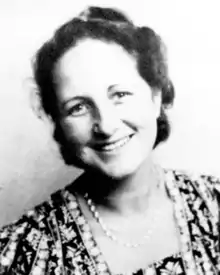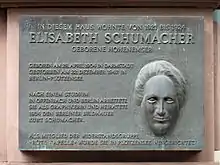Elisabeth Schumacher
Elisabeth Schumacher (née Hohenemser; 28 April 1904 – 22 December 1942 in Plötzensee Prison, Berlin) was a German graphic artists and photographer.[1] She was a member of the Berlin based anti-fascist resistance group[2] that was later called the Red Orchestra (Rote Kapelle) by the Abwehr, during the Third Reich. Schumacher also trained as an artist before joining the resistance efforts.

Life
Elisabeth Schumacher was born in a well-off family to a Jewish father and Christian mother in Darmstadt. Her father, engineer Fritz Hohenemser, was a soldier in World War I[3] and came from a family of prominent bankers from the Frankfurt am Main area. Her mother came from Meiningen.[4] In 1914, the family moved from Strasbourg (then part of Germany) to Frankfurt am Main. During the same year, Fritz Hohenemser died in action in the First World War, leading Elisabeth to move to Meiningen with her mother and siblings.
In 1921, Schumacher attended the School of Applied Arts (Kunstgewerbeschule) in Offenbach on and off until 1925. She worked at a crafts studio until 1928, in order to study art in Berlin, which she did until 1933. After completing her studies, Schumacher stayed in Berlin and applied for a permanent spot at the Reich Office for Industrial Safety. However, she was turned away because she was half-Jewish. This reason led to more difficulties finding a steady job, and as a result, Schumacher had to freelance. She was also active at the German Labour Museum (Deutsches Arbeitsmuseum).
While living in Berlin, Schumacher met Kurt Schumacher and had been close friends since 1930.[5] Schumacher had been studying graphic art with German artist Ernst Böhm as part of a three year course.[5] At the end of the course in 1933, Schumacher attained a position as a freelance graphic artist at the German Occupational Safety and Health Museum in Charlottenburg.[5]
Kurt Schumacher was an anti-Nazi and sculptor. Together, Elisabeth and Kurt formed an organization to fight against Hitler's regime. The beginning of World War II strengthened the need for this organization, and Elisabeth became more involved. The Schumachers spent much time helping those affected by Nazi Germany, but were ultimately arrested in September of 1942. Elisabeth, along with her husband, died in December of the same year.
Resistance Activities
Elisabeth and her husband were inspired by Libertas and Harro Schulze-Boysen, and created an organization to fight against the Nazi regime. The start of World War II solidified this resolve. Later, the Schumachers joined Libertas and Harro Schulze-Boysen, along with Mildred and Arvid Harnack in their spy network, whom the Gestapo later dubbed the "Red Orchestra" (Rote Kapelle). The group was active giving out handbills and documenting the Nazi regime's crimes.
Schumacher wanted to protect Jewish relatives from deportation. Moreover, she believed there were possibilities of negotiating peace with the Soviet Union. Early in 1941, the Schumachers were involved in the attempt to warn the Soviet Union by wireless about the forthcoming German invasion (Operation Barbarossa). In August 1942, they took in the Communist Albert Hößler (or Hoessler), who had lived in the Soviet Union since the 1930s. He parachuted into Germany to support the resistance group's transmission of information to the Soviet Union.
Arrest and death

In 1942, after a wireless message was decoded, many members of the resistance group were arrested. On 12 September of that year, Schumacher was arrested at her flat. Like her husband, she was sentenced to death on 19 December 1942 at the Reichskriegsgericht ("Reich Military Tribunal") for "conspiracy to commit high treason", espionage, and other political crimes. Schumacher was beheaded on 22 December 1942 at Plötzensee Prison, forty-five minutes after her husband was hanged there.[6]
Quotes from Elisabeth Schumacher
- "This war takes on ever crazier forms."[7]
- — March 1941
- "There is a dreadful amount of hopelessness and misery here at every turn. Typhus has broken out in the Jewish barracks."[8]
- — from a letter to her family, 1941
Bibliography
- Fischer-Defoy, Christine (1988). Kunst, Macht, Politik : die Nazifizierung der Kunst- und Musikhochschulen in Berlin (in German). Berlin: Elefanten Press. ISBN 3-88520-271-9. OCLC 923307412.
- Luise Kraushaar; Institut für Marxismus-Leninismus beim ZK der SED (1970). Deutsche Widerstandskämpfer 1933-1945 (in German). Berlin: Dietz-Verlag. OCLC 1149300905.
- Rosiejka, Gert (1986). Die Rote Kapelle "Landesverrat" als antifaschist. Widerstand (in German) (1st ed.). Hamburg: Ergebnisse Verlag. ISBN 9783925622168. OCLC 497259004.</ref>
References
- Corina L. Petrescu (2010). Against All Odds: Models of Subversive Spaces in National Socialist Germany. Peter Lang. p. 191. ISBN 978-3-03911-845-8. Retrieved 12 January 2021.
- "German Resistance Memorial Center - 14 The Red Orchestra". www.gdw-berlin.de. Retrieved 2019-03-01.
- "Elisabeth Schumacher (geb. Hohenemser)". Stolpersteine in Berlin (in German). Koordinierungsstelle Stolpersteine Berlin. Retrieved 12 January 2021.
- "Folge 3: Elisabeth Schumacher geb. Hohenemser". Stadt Kultur Magazin (in German). Darmstadt: Echo Zeitungen GmbH. August 2015. Retrieved 12 January 2021.
- Geertje Andresen (1 November 2005). Oda Schottmüller: Die Tänzerin, Bildhauerin und Nazigegnerin Oda Schottmüller (1905–1943) (in German). Lukas Verlag. p. 319. ISBN 978-3-936872-58-3. Retrieved 12 January 2021.
- Short biography of Elisabeth Schumacher German Resistance Memorial Center. Retrieved March 28, 2010
- Original German: Dieser Krieg nimmt immer wahnwitzigere Formen an.
- Original German: Es gibt hier entsetzlich viel Trostlosigkeit und Elend auf Schritt und Tritt. Im Judenlager ist Flecktyphus ausgebrochen.
| Wikimedia Commons has media related to Elisabeth Schumacher. |